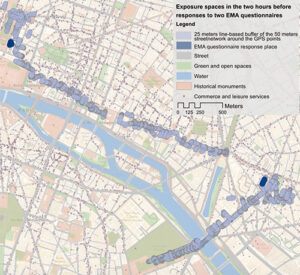Measuring the exposure to urban landscapes along daily mobility paths and their effects on momentary depressive symptomatology among older population
The urban environment plays an important role for the mental health of residents. Researchers mainly focus on residential neighbourhoods as exposure context, leaving aside the effects of non-residential environments. In order to consider the daily experience of urban spaces, a people-based approach focused on mobility paths is needed.
Applying this approach, a study realized by Giovanna Fancello (in collaboration with Julie Vallée, Cédric Sueur, Frank van Lenthe, Yan Kestens, Andrea Montanari and Basile Chaix) investigated whether individuals’ momentary mental well-being is related to the exposure to micro-urban spaces along the daily mobility paths within the two previous hours; it explored whether these associations differ when environmental exposures are defined considering all location points or only outdoor location points; and it examined the associations between the types of activity and mobility and momentary depressive symptomatology.
 Using a geographically explicit ecological momentary assessment approach (GEMA), momentary depressive symptomatology of 216 older adults living in the Ile-de-France region was assessed using smartphone surveys, while participants were tracked with a GPS receiver and an accelerometer for seven days. Exposure to multiple elements of the streetscape was computed within a street network buffer of 25 m of each GPS point over the two hours prior to the questionnaire. Mobility and activity type were documented from a GPS-based mobility survey. The authors estimated Bayesian generalized mixed effect models with random effects at the individual and day levels and took into account time autocorrelation. They also estimated fixed effects.
Using a geographically explicit ecological momentary assessment approach (GEMA), momentary depressive symptomatology of 216 older adults living in the Ile-de-France region was assessed using smartphone surveys, while participants were tracked with a GPS receiver and an accelerometer for seven days. Exposure to multiple elements of the streetscape was computed within a street network buffer of 25 m of each GPS point over the two hours prior to the questionnaire. Mobility and activity type were documented from a GPS-based mobility survey. The authors estimated Bayesian generalized mixed effect models with random effects at the individual and day levels and took into account time autocorrelation. They also estimated fixed effects.
“Higher momentary mental well-being was observed after participants performed outdoor activities in spaces with pedestrian areas (pedestrian dedicated paths, open spaces, parks and green areas), water elements or with commerce, leisure and cultural attractors. These results could be explained by the sense of safety and autonomy given to elderly people by walkable spaces, as well as by their capacity to provide easy access to services and to favour sociability, as demonstrated by the large body of literature on walkability spaces”.
Discussion and conclusions, p. 8
A better momentary mental wellbeing was observed when residents performed leisure activities or were involved in active mobility and when they were exposed to walkable areas (pedestrian dedicated paths, open spaces, parks and green areas), water elements, and commerce, leisure and cultural attractors over the previous two hours. These relationships were stronger when exposures were defined based only on outdoor location points rather than all location points, and when we considered within-individual differences compared to between-individual differences.
Giovanna Fancello, Julie Vallée, Cédric Sueur, Frank van Lenthe, Yan Kestens, Andrea Montanari and Basile Chaix. Micro urban spaces and mental well-being: Measuring the exposure to urban landscapes along daily mobility paths and their effects on momentary depressive symptomatology among older population. Environment International, 2023, 178, pp.108095. 10.1016/j.envint.2023.108095. hal-04196417
 Julie Vallée, Senior researcher (CNRS / Géographie-cités), is conducting research devoted to spatial mechanisms of social inequalities in urban areas, with a particular interest towards people’s daily mobility.
Julie Vallée, Senior researcher (CNRS / Géographie-cités), is conducting research devoted to spatial mechanisms of social inequalities in urban areas, with a particular interest towards people’s daily mobility.
Read more:
Intersectional approach of everyday geography. Environment and Planning B: Urban Analytics and City Science. Preprint HAL & ArXiv
Everyday geography and service accessibility: the contours of disadvantage in relation to mental health. Annals of the American Association of Geographers. ⟨hal-03343684⟩


